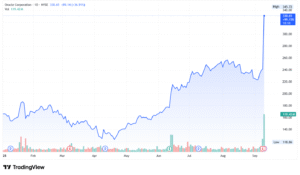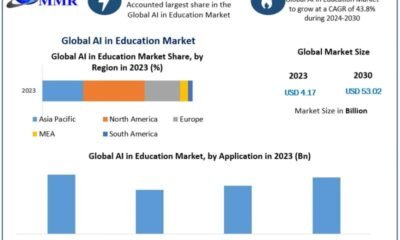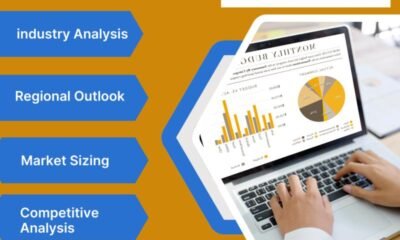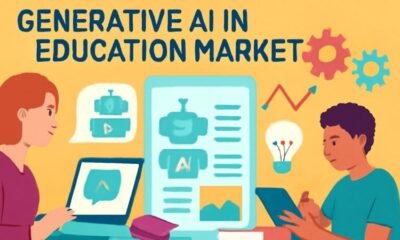AI Insights
Artificial Intelligence (AI) Supercomputer Market Hits New

HTF MI just released the Global Artificial Intelligence (AI) Supercomputer Market Study, a comprehensive analysis of the market that spans more than 143+ pages and describes the product and industry scope as well as the market prognosis and status for 2025-2032. The marketization process is being accelerated by the market study’s segmentation by important regions. The market is currently expanding its reach.
Major Giants in Artificial Intelligence (AI) Supercomputer Market are:
NVIDIA (USA), IBM (USA), Google (USA), Microsoft (USA), Amazon AWS (USA), Huawei (China), Baidu (China), Fujitsu (Japan), Lenovo (China), Cray (USA), Intel (USA), AMD (USA), Graphcore (UK), Cerebras Systems (USA), NEC (Japan)
Request PDF Sample Copy of Report: (Including Full Toc, List of Tables & Figures, Chart) @
👉 https://www.htfmarketinsights.com/sample-report/4367485-artificial-intelligence-ai-supercomputer-market?utm_source=Vaishali_OpenPR&utm_id=Vaishali
HTF Market Intelligence projects that the global Artificial Intelligence (AI) Supercomputer market will expand at a compound annual growth rate (CAGR) of 27% from 2025 to 2032, from 10.5 Billion in 2025 to 40.0 Billion by 2032.
Our Report Covers the Following Important Topics:
By Type:
GPU-based, TPU-based, Neuromorphic, Quantum-enhanced, FPGA-based
By Application:
Scientific Research, Weather Forecasting, Drug Discovery, Autonomous Systems, Financial Modeling
Definition:
AI Supercomputers are high-performance computing systems optimized for AI workloads, such as deep learning training and inference. They feature specialized hardware like GPUs and TPUs designed for massive parallel processing. These systems accelerate AI innovation by handling huge datasets and complex models, enabling breakthroughs in science, medicine, and technology on a global scale.
Dominating Region:
North America
Fastest-Growing Region:
Asia-Pacific
Market Trends:
• Specialized hardware, Quantum computing, Energy efficiency, Edge AI, Cloud integration
Market Drivers:
• AI research demand, Hardware innovation, Cloud computing growth, Big data expansion, Government investments
Market Challenges:
• Costly infrastructure, Power consumption, Complexity, Talent shortage, Scalability
Market Opportunities:
• Scientific breakthroughs, AI democratization, Industry automation, Climate modeling, Personalized medicine
Buy Now Latest Edition of Artificial Intelligence (AI) Supercomputer Market Report 👉 https://www.htfmarketinsights.com/buy-now?format=1&report=4367485
The titled segments and sub-section of the market are illuminated below:
In-depth analysis of Artificial Intelligence (AI) Supercomputer market segments by Types: GPU-based, TPU-based, Neuromorphic, Quantum-enhanced, FPGA-based
Detailed analysis of Career &Education Counselling market segments by Applications: Scientific Research, Weather Forecasting, Drug Discovery, Autonomous Systems, Financial Modeling
Global Artificial Intelligence (AI) Supercomputer Market – Regional Analysis
• North America: United States of America (US), Canada, and Mexico.
• South & Central America: Argentina, Chile, Colombia, and Brazil.
• Middle East & Africa: Kingdom of Saudi Arabia, United Arab Emirates, Turkey, Israel, Egypt, and South Africa.
• Europe: the UK, France, Italy, Germany, Spain, Nordics, BALTIC Countries, Russia, Austria, and the Rest of Europe.
• Asia: India, China, Japan, South Korea, Taiwan, Southeast Asia (Singapore, Thailand, Malaysia, Indonesia, Philippines & Vietnam, etc.) & Rest
• Oceania: Australia & New Zealand
Artificial Intelligence (AI) Supercomputer Market Research Objectives:
– Focuses on the key manufacturers, to define, pronounce and examine the value, sales volume, market share, market competition landscape, SWOT analysis, and development plans in the next few years.
– To share comprehensive information about the key factors influencing the growth of the market (opportunities, drivers, growth potential, industry-specific challenges and risks).
– To analyze the with respect to individual future prospects, growth trends and their involvement to the total market.
– To analyze reasonable developments such as agreements, expansions new product launches, and acquisitions in the market.
– To deliberately profile the key players and systematically examine their growth strategies.
FIVE FORCES & PESTLE ANALYSIS:
Five forces analysis-the threat of new entrants, the threat of substitutes, the threat of competition, and the bargaining power of suppliers and buyers-are carried out to better understand market circumstances.
• Political (Political policy and stability as well as trade, fiscal, and taxation policies)
• Economical (Interest rates, employment or unemployment rates, raw material costs, and foreign exchange rates)
• Social (Changing family demographics, education levels, cultural trends, attitude changes, and changes in lifestyles)
• Technological (Changes in digital or mobile technology, automation, research, and development)
• Legal (Employment legislation, consumer law, health, and safety, international as well as trade regulation and restrictions)
• Environmental (Climate, recycling procedures, carbon footprint, waste disposal, and sustainability)
Get customized report 👉 https://www.htfmarketinsights.com/customize/4367485-artificial-intelligence-ai-supercomputer-market?utm_source=Vaishali_OpenPR&utm_id=Vaishali
Points Covered in Table of Content of Global Artificial Intelligence (AI) Supercomputer Market:
Chapter 01 – Artificial Intelligence (AI) Supercomputer Executive Summary
Chapter 02 – Market Overview
Chapter 03 – Key Success Factors
Chapter 04 – Global Artificial Intelligence (AI) Supercomputer Market – Pricing Analysis
Chapter 05 – Global Artificial Intelligence (AI) Supercomputer Market Background or History
Chapter 06 – Global Artificial Intelligence (AI) Supercomputer Market Segmentation (e.g. Type, Application)
Chapter 07 – Key and Emerging Countries Analysis Worldwide Artificial Intelligence (AI) Supercomputer Market
Chapter 08 – Global Artificial Intelligence (AI) Supercomputer Market Structure & worth Analysis
Chapter 09 – Global Artificial Intelligence (AI) Supercomputer Market Competitive Analysis & Challenges
Chapter 10 – Assumptions and Acronyms
Chapter 11 – Artificial Intelligence (AI) Supercomputer Market Research Method Artificial Intelligence (AI) Supercomputer
Thank you for reading this post. You may also obtain report versions by area, such as North America, LATAM, Europe, Japan, Australia, or Southeast Asia, or by chapter.
Nidhi Bhawsar (PR & Marketing Manager)
HTF Market Intelligence Consulting Private Limited
Phone: +15075562445
sales@htfmarketreport.com
About Author:
HTF Market Intelligence Consulting is uniquely positioned to empower and inspire with research and consulting services to empower businesses with growth strategies, by offering services with extraordinary depth and breadth of thought leadership, research, tools, events, and experience that assist in decision-making.
This release was published on openPR.
AI Insights
Oracle (ORCL) Stock Soars 40% on AI Boom and $455B Cloud Backlog While Going Green

Oracle Corporation (NASDAQ: ORCL) surprised the markets today with a dramatic stock rally. Its shares jumped more than 40%, reaching record highs and placing the company near the trillion-dollar club. This sharp increase was powered by huge demand for Oracle’s cloud services, especially for artificial intelligence (AI) and big partnerships.
Wall Street focused on the financial side, but Oracle also highlighted something else: its environmental goals. The company wants to show that fast growth can go hand in hand with sustainability. By investing in both AI and green programs, Oracle is shaping an image as a modern tech leader that balances profit with responsibility.
Record-Breaking Rally: Oracle’s Biggest Jump in Decades
The jump in Oracle’s stock was its largest in more than 30 years. Investors reacted to news that Oracle signed multiple multi-billion-dollar contracts with tech giants such as OpenAI, Meta, and NVIDIA.
These contracts are tied to AI cloud services and pushed Oracle’s contract backlog to around $455 billion, a sharp rise from $130 billion just a quarter earlier.

This backlog shows how fast demand for Oracle Cloud Infrastructure (OCI) is growing. The company responded by raising its forecast for OCI revenue. It now expects 77% growth this fiscal year, higher than its earlier estimate of 70%. The company also predicts $18 billion in cloud revenue in 2025 and has set a long-term target of $144 billion by 2030.
The growth reflects the global rush to build AI systems. Oracle has placed itself at the center of this movement, partnering in major projects such as the Stargate initiative led by SoftBank and OpenAI. These deals highlight Oracle’s role in powering the next generation of AI.
Recent Developments Strengthening Oracle’s Position
On top of these strong results, Oracle has made headlines with two new announcements that underline its growing role in AI.
The first is a massive deal with OpenAI. Beginning in 2027, OpenAI will purchase at least $300 billion worth of computing power from Oracle over five years. This is one of the largest cloud agreements in history, and it shows how central Oracle has become to advanced AI systems. For Oracle, it marks a major vote of confidence from one of the most important AI companies in the world.
Oracle’s stock surged to a record high. This boosted the company’s market value to nearly $1 trillion. The rally also made headlines for another reason: it boosted co-founder Larry Ellison’s wealth by more than $100 billion in a single day, making him the world’s richest person.
Greener Growth: Oracle’s Path to Net Zero
Amid the AI excitement and stock rally, Oracle is pushing its green message. The company has promised to be carbon neutral by 2050. It also set a nearer goal to cut greenhouse gas emissions in half by 2030, using 2020 as its baseline year. These goals cover its offices, data centers, and cloud services.



Oracle has already achieved some key milestones:
- Renewable power: 86% of OCI’s global energy came from renewables in 2023.
- Regional progress: Europe and Latin America already run on 100% renewable power.
- Global ambition: Oracle plans to hit 100% renewable energy worldwide by 2025.
- Water and waste: Since 2020, water use has dropped by almost 25% and landfill waste by more than 35%.
- Travel impact: Employee air travel emissions have been cut by 38% thanks to more virtual meetings.
These achievements prove Oracle is not only talking about sustainability but also acting on it. For a company scaling up fast in cloud and AI, these steps are important. They show Oracle is trying to balance expansion with its responsibility to the planet.
Pushing Green Standards Across the Supply Chain
Oracle knows its environmental impact extends beyond its own walls. A big part of its footprint comes from suppliers. That’s why the company is pushing its partners to meet strict environmental standards.



Here are some of the key steps:
- Supplier programs: All major suppliers must have environmental programs.
- Emission targets: At least 80% of suppliers are expected to set formal climate goals.
- Progress: More than four in five suppliers already meet these expectations.
- Broader impact: By setting these standards, Oracle ensures its ESG efforts reach across its global supply chain.
This approach boosts Oracle’s credibility. It tells investors and clients that the company’s sustainability commitments are not limited to its own operations. Instead, they cover the full ecosystem of partners that make its technology possible.
AI-Powered Tools for Climate Accountability
Oracle is also building tools to help other companies meet their climate goals. One of these is Fusion Cloud Enterprise Performance Management (EPM) for ESG. This platform allows organizations to automate sustainability reporting, integrate emissions data with financial information, and align with global standards.
The system uses AI to make reporting easier and more accurate. This is important as regulators push companies to disclose their environmental impacts in more detail.
-
It combines Scope 1, 2, and 3 emissions data based on the GHG Protocol Corporate Standard. This links emissions to financial and operational data, helping with better ESG management.
-
Oracle improved its ESG reporting with this platform. They cut reporting timelines by 30% using automation and AI-driven process management.
-
The platform collects unique identifiers from source documents. This ensures clear data tracking and auditability. It boosts transparency and lowers compliance risks.
-
It supports global reporting standards like IFRS, ESRS (CSRD), and GRI. This helps organizations align their disclosures with changing regulations easily.
Oracle has also introduced features in its cloud infrastructure that estimate emissions from customer workloads. This means clients can see how much carbon their computing generates and adjust operations to stay on track with their own sustainability commitments. By doing this, Oracle is not only greening its own business but also helping others.
The Tough Road Ahead: Energy Demands vs. Climate Goals
Still, Oracle faces challenges in meeting its promises. Reaching 100% renewable energy worldwide is difficult, especially in regions where clean energy options are limited. Ensuring suppliers stick to emissions goals is also complex, given the size of Oracle’s global network.
Another challenge is the massive energy demand of AI. As Oracle expands its role in AI infrastructure, its energy use will rise. Balancing this growth with its climate goals will require new investment in efficient data centers, renewable sourcing, and innovations in green computing.
Oracle’s record-breaking stock surge highlights its importance in the AI and cloud industry. But what makes its story more powerful is the balance it is trying to strike between growth and sustainability. By pledging net zero emissions by 2050, setting ambitious near-term targets, and building tools for others to track emissions, Oracle is showing that technology and responsibility can go together.
For investors, Oracle now offers both a high-growth AI story and a strong ESG narrative. For customers, it provides powerful cloud services backed by renewable energy and transparent carbon data.
As Oracle continues to grow, its ability to deliver on both financial and environmental goals may define its future as one of the world’s most influential technology leaders.
AI Insights
Loneliness Is Reshaping Your Workplace

As a seasoned senior vice president at a global tech firm, Sharon wasn’t expecting to feel emotional while listening to a keynote. But as former U.S. Surgeon General Dr. Vivek Murthy spoke, describing how loneliness has become a public health crisis, something clicked. “It wasn’t that the information was new,” she told us. “It was that I suddenly saw the evidence everywhere—in my team, in our culture, even in myself.”
AI Insights
Procure IT Names Corey Whiting as Chief Artificial Intelligence Officer
In addition to his role as CAIO, Whiting joins Andrew Laughter, CEO Randy Jeter and CIO Phil Ben-Joseph as a Partner in Procure IT. He will work with Laughter at the company’s Winter Park, Fla., office.
Corey Whiting: A Career Built on Data and Intelligence
Whiting brings 26 years of software engineering and data innovation to Procure IT. He has a Bachelor of Science and a Master of Science in Computer Science, and a career defined by turning data into insights that drive business outcomes.
He began his career at Stats Perform, where he developed algorithms and analytics from sports data sets. Building on that experience, he went on to found BaseballCloud, a platform delivering data-driven scouting and player development insights. Later, he co-founded RoyFi, a fintech company that leveraged music streaming data to accurately project music royalties and provide funding for artists, combining predictive analytics with financial impact.
“My role at Procure IT is about embedding intelligence everywhere, taking the data we have and turning it into insights that drive better, faster IT business decisions,” said Whiting. “The opportunity here is huge to turn all this data into managed intelligence so that companies can make smarter decisions at scale.”
Accelerating AI-Driven Decisions
Whiting will oversee the continued development of Procure IT’s Managed Intelligence Platform, including integration and application of the company’s AI Virtual Assistant (AVA). AVA gives enterprises instant, conversational access to insights across their entire IT stack — from usage and licenses to contracts, financials and performance metrics — shifting from static dashboards to real-time, actionable intelligence.
“Dashboards are dead,” said Whiting. “Organizations don’t want to dig through data — they want answers. Procure IT’s Managed Intelligence Platform gives them those answers instantly, in context and ready to act on.”
With Whiting leading the company’s AI strategy, Procure IT is doubling down on embedding intelligence throughout the platform, a move CIO Ben-Joseph says positions the company to be the leading Managed Intelligence Platform for Technology Advisors, Value Added Resellers (VARs) and Managed Service Providers (MSPs).
“Agentic AI is going to reshape how IT environments are managed,” said Ben-Joseph. “We’re building Procure IT’s platform to make sure enterprises are ready for that shift, helping them understand, control and optimize their data like never before.”
Our Channel-First Approach
Procure IT goes to market exclusively through a global network of technology advisors, MSPs, VARs and solution providers who use the Procure IT Managed Intelligence Platform to audit and optimize client IT environments while tapping recurring revenue opportunities through commissions, license-funded engagement models and advisory services.
With Procure IT, partners can deliver real-time intelligence across their clients’ entire IT stack — from spend and contracts to usage and performance analytics. Built-in AI insights, benchmarking and automated reporting allow partners to provide strategic, data-driven recommendations that drive cost savings, efficiency and long-term business value.
More Information
To learn more about leveraging the Procure IT Managed Intelligence Platform to simplify and optimize your company’s IT environment, visit www.procureit.com. To speak to a Procure IT procurement expert, visit www.procureit.com/contact or email [email protected].
Partners interested in learning more about becoming a Procure IT partner can contact Procure IT at [email protected].
About Procure IT
Procure IT is transforming IT decisions with its Managed Intelligence Platform by enabling companies to optimize their own data to make informed and intelligent business decisions. Our flagship AI-driven SaaS platform streamlines sourcing, spend management and vendor oversight through a single-pane-of-glass experience designed for midmarket and enterprise businesses. Procure IT goes to market exclusively through a network of technology advisors, MSPs, VARs and solution providers, empowering partners to deliver real-time intelligence and strategic insights across their business clients’ IT environments.
With core modules spanning Cloud FinOps, SaaS FinOps, Technology Expense Management, Contract Management, Supplier Insights and Supplier Analytics, the platform delivers the tools and intelligence enterprises need to manage technology spend and performance at scale. Using built-in AI, benchmarking and automated reporting, Procure IT enables partners and their clients to reduce costs, minimize risk and achieve better outcomes across the entire IT lifecycle. For more information, visit www.procureit.com or engage with us on LinkedIn.
Media Contact
Randy Jeter, Procure IT, 1 949.245.2978, [email protected], www.procureit.com
Khali Henderson, BuzzTheory (for Procure IT), 1 480.848.6726, [email protected], www.buzztheory.com
SOURCE Procure IT

-

 Business2 weeks ago
Business2 weeks agoThe Guardian view on Trump and the Fed: independence is no substitute for accountability | Editorial
-
Tools & Platforms1 month ago
Building Trust in Military AI Starts with Opening the Black Box – War on the Rocks
-

 Ethics & Policy2 months ago
Ethics & Policy2 months agoSDAIA Supports Saudi Arabia’s Leadership in Shaping Global AI Ethics, Policy, and Research – وكالة الأنباء السعودية
-

 Events & Conferences4 months ago
Events & Conferences4 months agoJourney to 1000 models: Scaling Instagram’s recommendation system
-

 Jobs & Careers2 months ago
Jobs & Careers2 months agoMumbai-based Perplexity Alternative Has 60k+ Users Without Funding
-

 Podcasts & Talks2 months ago
Podcasts & Talks2 months agoHappy 4th of July! 🎆 Made with Veo 3 in Gemini
-

 Education2 months ago
Education2 months agoMacron says UK and France have duty to tackle illegal migration ‘with humanity, solidarity and firmness’ – UK politics live | Politics
-

 Education2 months ago
Education2 months agoVEX Robotics launches AI-powered classroom robotics system
-

 Funding & Business2 months ago
Funding & Business2 months agoKayak and Expedia race to build AI travel agents that turn social posts into itineraries
-

 Podcasts & Talks2 months ago
Podcasts & Talks2 months agoOpenAI 🤝 @teamganassi



















